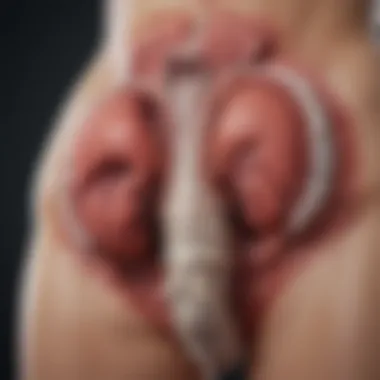Comprehensive Guide to Fibromioma Uteri: Causes and Treatments


Intro
Fibromioma uteri, or uterine fibroids, represent a common yet complex condition impacting countless women across diverse demographics. Understanding this health issue requires us to unravel various threads—its origins, the symptoms individuals may encounter, and the baskets of treatment options available.
This article aims to take a comprehensive dive into the world of fibromiomas, shedding light on not just the health implications but also the socio-economic contexts surrounding this condition. A reader embarking on this journey will soon realize that knowledge empowers both understanding and choice in managing one’s health.
Article Overview
Purpose of the Article
The primary aim is to furnish readers with a robust resource on fibromioma uteri. We will dissect its causes, symptoms, and the plethora of treatment strategies that medical science has to offer. For students pursuing healthcare-related fields or for educators seeking to enrich their curriculum, this article serves as an educational tool. Meanwhile, any woman experiencing fibromas, or their support network, can find practical advice tailored to daily living and healthcare navigation.
Relevance to Multiple Disciplines
Fibromioma uteri intersect various fields—from gynecology and women’s health to psychology and social sciences. The impacts range in patients’ physical health to emotional well-being and even economic consequences related to healthcare access and reproductive rights. Therefore, this topic is not limited to medical students or professionals but resonates across societal strands, affecting policy discussions and public health initiatives.
Research Background
Historical Context
The study of fibromioma dates back centuries, with ancient texts documenting similar conditions under various names. Historically, they were often misunderstood or dismissed as mere inconveniences; modern research has uncovered a wealth of information about their prevalence and impact.
Key Concepts and Definitions
To navigate this topic effectively, several key terms must be defined clearly:
- Fibromioma Uteri: Noncancerous growths of the uterus that often appear during childbearing years.
- Symptoms: Can range from heavy menstrual bleeding to pelvic pain.
- Treatment Options: Encompass everything from medication to surgical interventions.
Understanding these definitions lays a solid foundation for exploring the more intricate aspects of fibromiomas and their management.
"Awareness is the first step in taking charge of your health. Knowing what fibromiomas can entail enables women to make informed choices about their bodies and wellbeing."
"Awareness is the first step in taking charge of your health. Knowing what fibromiomas can entail enables women to make informed choices about their bodies and wellbeing."
The upcoming sections will delve deeper into these areas, offering insights and guidance that are essential for a comprehensive understanding of fibromioma uteri.
Prelims to Fibromioma Uteri
Fibromioma uteri, or uterine fibroids, represent a significant concern within the realm of women's health. The prominence of this topic is underscored by the fact that a considerable proportion of women will bear the burden of these benign tumors at some point in their lives. Understanding fibromiomas is not merely academic; it holds practical implications for diagnosis, treatment, and overall quality of life.
In this article, we will unravel the many layers of fibromiomas, encompassing everything from their definition to potential treatment options. Grasping the nuances surrounding these growths can empower patients, healthcare professionals, and researchers alike to address symptoms and promote informed decision-making.
Definition and Overview
Fibromiomas are non-cancerous growths that develop within or on the walls of the uterus. Scientifically, they are recognized as leiomyomas and can vary dramatically in size, from as small as a pea to larger than a grapefruit. The precise mechanisms of their formation remain a riddle, yet hormones—particularly estrogen—play a pivotal role in their development.
These growths can arise in different forms, classified largely based on their location:
- Intramural Fibroids: Located within the uterine wall.
- Subserosal Fibroids: Found on the outer surface of the uterus.
- Submucosal Fibroids: Situated just beneath the uterine lining.
- Pedunculated Fibroids: Attached to the uterus by a stalk.
Each type can present a unique set of symptoms and treatment challenges, highlighting the importance of accurate diagnosis to tailor effective management plans.
Historical Context
The understanding of fibromiomas has evolved over centuries. Historical records indicate that women have discussed symptoms akin to those of fibromiomas for ages, though clinical frameworks to diagnose and treat them were sparse. Early medical literature lacked the sophistication of modern imaging techniques, often leading to misdiagnosis or mistreatment.
It wasn't until the late 19th and early 20th centuries that the medical community began to establish more rigorous classification systems and treatment protocols. The advancement of imaging technologies, like ultrasound, was a game-changer, allowing for better visualization of the fibroids and more reliable diagnoses.
In recent years, ongoing research has shifted focus toward understanding genetic and environmental factors that contribute to fibromioma formation. Current studies aim to provide insight into effective treatments, ultimately improving the quality of life for those affected.
Underpinning this historical context is a recognition of the social and health disparities that continue to affect women, particularly women of color, emphasizing the urgency of addressing both the medical and societal implications of fibromioma uteri.
Epidemiology of Fibromioma Uteri
Understanding the epidemiology of fibromioma uteri is essential for grasping how common these growths are among women and recognizing the demographic variations that may influence their occurrence. By assessing the patterns and frequencies of fibromiomas, researchers can identify potential risk factors, leading to better prevention strategies and tailored treatment options.
Prevalence Among Women
Fibromiomas are notably widespread, affecting a significant number of women during their reproductive years. Studies show that approximately 70 to 80 percent of women may develop fibromas by the age of 50. The actual prevalence can vary, as many women do not exhibit any symptoms, which can lead to underreporting. The presence of fibromas is generally more common in older women, particularly those aged between 30 and 50.
It’s critical to note that while fibromas are often benign, their presence can lead to various complications, affecting a woman’s quality of life.
It’s critical to note that while fibromas are often benign, their presence can lead to various complications, affecting a woman’s quality of life.
Moreover, the prevalence of these growths can differ based on several factors, such as ethnicity and lifestyle choices. For example, studies indicate that African American women may be more likely to develop fibromas than their Caucasian counterparts, and tend to experience more severe symptoms.
Demographic Influences
The demographic landscape surrounding fibromiomas is multifaceted. Various aspects such as age, ethnicity, and socioeconomic status can significantly influence a woman's risk of developing fibromas.
- Age: Age is a defining factor; as mentioned earlier, fibromas are more prevalent in women in their 30s and 40s.
- Ethnicity: Ethnic background plays a substantial role. Research has highlighted that African American women are at a higher risk of developing fibromas compared to Hispanic and Caucasian women. Larger studies suggest that this group may develop fibromas earlier and with greater severity.
- Body Mass Index (BMI): Obesity has also been correlated with the presence of fibromiomas. Women with a higher BMI are more likely to develop these growths due to increased estrogen levels.
- Family History: Genetic predisposition cannot be overlooked. A family history of fibromas increases the likelihood of a woman developing them herself.
By examining these demographic influences, healthcare providers can better understand their patient populations, leading to improved outreach and education about fibromas. The aim is to foster awareness and empower women to recognize symptoms early and seek appropriate intervention.
Ultimately, the epidemiology of fibromioma uteri emphasizes not only the significance of these growths but also the importance of understanding the factors that contribute to their occurrence. This awareness can lead to better health outcomes and informed discussions about management strategies.
Types of Fibromiomas
Understanding the different types of fibromiomas is vital for grasping how they can affect a woman’s health and well-being. Each type has distinct characteristics, implications for symptoms, and considerations for treatment options. This section delves into the classifications of fibromiomas, explaining their specific attributes. Such knowledge not only empowers patients in their care decisions but also facilitates effective communication with healthcare providers.
Intramural Fibroids
Intramural fibroids form within the muscular wall of the uterus. They are the most common type of fibroid and can vary greatly in size. Intramural fibroids can cause an increase in the overall uterine size, which may lead to various symptoms.
- Symptoms: Many women with intramural fibroids may struggle with heavy menstrual bleeding, pelvic pain, and pressure on adjacent organs. Some may even experience difficulties during intercourse or issues related to urinary urgency.
- Diagnosis: These fibroids are often diagnosed during routine pelvic exams or imaging tests such as ultrasound. Their relatively deep location within the uterine wall may sometimes make them harder to detect without advanced imaging.
Subserosal Fibroids
Subserosal fibroids are located on the outer surface of the uterus. This placement can lead these fibroids to push against adjacent structures as they grow, creating a range of symptoms.
- Symptoms: Women might experience abdominal discomfort, pressure symptoms, or even back pain due to the proximity to surrounding organs. Some cases result in higher rates of urinary issues, depending on their size and location.
- Diagnosis: Similar to intramural fibroids, subserosal fibroids are often identified with imaging techniques. When they grow large enough, they can be seen during routine gynecological examinations.


Submucosal Fibroids
Submucosal fibroids sit just beneath the lining of the uterus. These are not as common as the other types but can significantly impact a woman's menstrual cycle and overall reproductive health.
- Symptoms: These fibroids are notorious for causing abnormal uterine bleeding, including prolonged periods or heavy bleeding between cycles. Some women may also encounter complications like infertility or repeated miscarriages due to their position.
- Diagnosis: Diagnosis often requires specialized imaging techniques, as they can sometimes be masked by the normal uterine lining.
Pedunculated Fibroids
Pedunculated fibroids are unique in that they are attached to the uterus by a stalk. This distinctive structure enables them to be categorized separately from other types.
- Symptoms: The symptoms can vary based on the size and location of the pedunculated fibroid. Many women report sharp pain if the stalk becomes twisted, which can lead to acute conditions requiring prompt medical attention.
- Diagnosis: Detection of pedunculated fibroids can be done with imaging methods or visual inspections during an examination. Their movement and isolation can sometimes make them easier to identify than other types.
Understanding these fibroid types is a stepping stone for women navigating the complexities of fibromioma uteri. It allows them to approach their health with informed clarity, addressing the nuances of what these growths mean for their bodies.
"Knowledge is power; understanding fibromas can lead to better management of one’s health."
"Knowledge is power; understanding fibromas can lead to better management of one’s health."
Potential Causes of Fibromioma Uteri
Understanding the potential causes of fibromioma uteri is essential for both patients and healthcare professionals, as it helps unlock the mysteries surrounding these common growths. Recognizing underlying influences can guide prevention strategies, inform symptom management, and shape treatment approaches. While the precise reasons fibromiomas develop remain somewhat elusive, several key factors emerge consistently in the literature and patient accounts.
Hormonal Factors
Hormones play a pivotal role when it comes to the formation and growth of fibromiomas. In particular, estrogen and progesterone are the main culprits thought to stimulate the development of these tumors. Fibromiomas tend to grow during years when hormone levels are elevated, such as during a woman’s reproductive years. After menopause, when hormone production decreases, fibromiomas often shrink. This cyclical response highlights why hormonal balance can be an essential focus area for those exploring treatment options.
For many patients, understanding this connection opens new avenues for symptom relief, such as hormonal therapies which aim to regulate levels in the body. It can also pave the way for lifestyle changes that might help modulate hormone production, like nutrition and exercise.
Genetic Predispositions
Another significant piece of the puzzle lies in genetic predispositions. Research indicates that women with a family history of fibromiomas are more likely to develop them themselves. Genes can influence not only the likelihood of developing fibromas but also characteristics such as size, number, and symptoms experienced.
If a woman's mother or sister has had fibromiomas, she may want to take proactive measures, such as regular check-ups and monitoring. Genetic studies are on the rise, and there’s a growing interest in identifying specific genetic markers that can provide insights into individual risks concerning fibromiomas.
Environmental Influences
The environment also plays a role in the dynamics surrounding fibromioma occurrences. Factors like diet, exposure to chemicals, or even lifestyle choices can contribute to the development of fibromas. For instance, studies have shown that a diet high in red meat and low in green vegetables and fruits may increase the risk.
Moreover, environmental toxins, like those found in certain plastics, could disrupt hormonal balance, indirectly contributing to fibroma growth. As more research emerges in this realm, it could lead to valuable insights into how lifestyle adjustments might mitigate risks or stave off the growth of fibromas altogether.
Other Contributing Factors
A variety of other elements could also contribute to the development of fibromiomas. One such factor is obesity, which has been linked to increased estrogen levels due to fat tissue's ability to produce the hormone. Inflammatory conditions and stress could also push the body into a state that might encourage the growth of fibromas.
This highlights the importance of taking a holistic viewpoint in both understanding and managing fibromiomas. Approaching treatment from multiple angles, including emotional well-being and lifestyle modifications, can create a more robust care strategy.
"Knowing the causes of fibromiomas isn't just academic; it’s a powerful tool for empowerment and self-advocacy for patients."
"Knowing the causes of fibromiomas isn't just academic; it’s a powerful tool for empowerment and self-advocacy for patients."
In summary, the potential causes of fibromioma uteri encompass a complex interplay of hormonal, genetic, environmental, and other factors. Those affected by or concerned about fibromas ought to delve into these areas to gain a deeper understanding of their condition. This knowledge not only informs management but also ensures a more personalized approach to treatment, ideally suited to each individual’s unique circumstances.
Symptoms Associated with Fibromioma Uteri
Understanding the symptoms associated with fibromioma uteri is crucial, as it profoundly affects a woman’s quality of life. These symptoms can range from mild to severe and often dictate the urgency with which a patient might seek medical intervention. Recognizing these symptoms is the first step in managing their impact, both physically and emotionally. Furthermore, the symptoms experienced can influence treatment options and long-term health outcomes. Therefore, an insightful exploration of these symptoms provides necessary context when discussing fibromiomas and their treatments.
Common Symptoms
Fibromiomas can present a variety of symptoms. While some women experience no symptoms at all, others may endure several from this list:
- Heavy Menstrual Bleeding: Many women report heavier than usual periods, which can lead to anemia if left unchecked.
- Pelvic Pain or Discomfort: Chronic pelvic pain is common, often described as a dull ache or pressure.
- Frequent Urination: The fibroids can put pressure on the bladder, leading to a constant urge to urinate.
- Difficulty Emptying the Bladder: This can occur alongside frequent urination, as larger fibroids may obstruct urinary flow.
- Constipation: Again, pressure on surrounding organs can contribute to digestive challenges.
- Pain During Intercourse: Some women describe discomfort during sexual activity, which can be distressing.
Fibromiomas might also manifest in less common, yet significant symptoms such as swelling in the abdomen, which can cause distress about body image.
Impact on Quality of Life
The symptoms of fibromioma uteri can significantly impact a woman’s day-to-day life. Here are some of the effects:
- Physical Limitations: Women may struggle with physical activities they once enjoyed due to pain or discomfort. Regular routines can become burdensome when faced with fatigue from heavy bleeding.
- Emotional Distress: The psychological toll cannot be ignored. Anxiety and stress related to unpredictable menstrual cycles or pelvic pain can affect mood and overall well-being.
- Social Implications: Concerns about leakage or sudden urges can lead to social withdrawal. This can affect personal relationships and overall social life.
- Impact on Work: Managing symptoms during work hours can be tricky. Frequent breaks and attendance issues may arise, leading to strained workplace relationships.
"Fibroids are not just a medical issue; they can become an emotional journey that affects every facet of a woman's life. Addressing these symptoms promptly is key to maintaining a positive quality of life."
"Fibroids are not just a medical issue; they can become an emotional journey that affects every facet of a woman's life. Addressing these symptoms promptly is key to maintaining a positive quality of life."
The effects of these symptoms extend beyond the medical realm, penetrating every layer of a woman’s existence. Therefore, acknowledging and diagnosing fibromioma symptoms should be accompanied by discussions on how they alter life as a whole, underlining the need for suitable management options.
Diagnostic Procedures
Diagnosing fibromioma uteri, or uterine fibroids, requires a careful, structured approach. Understanding these procedures is crucial because it not only facilitates an accurate diagnosis but also helps in determining the best course of action for treatment. This section highlights the key elements and benefits of various diagnostic methods.
Physical Examination
The first step in diagnosing fibromiomas often begins with a thorough physical examination. A healthcare provider typically checks for any abnormalities in the abdomen or pelvic region. During this examination, the doctor may palpate the uterus to identify any unusual growths or tenderness. This is an important step as it can alert the physician to potential issues that may require further investigation.
Women are often advised to share any symptoms they have been experiencing in detail. This can guide the examination. If fibromas are suspected, the healthcare provider might recommend additional imaging tests for a clearer picture.
Imaging Techniques
Ultrasound
Ultrasound remains one of the most common techniques for diagnosing fibromiomas. It utilizes sound waves to create images of the uterus, allowing for the visualization of any fibroids present. A key characteristic of ultrasound is its non-invasive nature, making it accessible and tolerable for most patients.
A unique feature of ultrasound is its real-time imaging capability; this allows healthcare providers to assess the size and location of the fibroids accurately.
Advantages of Ultrasound:
- Non-invasive and painless
- Can be performed in an outpatient setting
- Immediate results available
Disadvantages of Ultrasound:
- May not always provide clear images of smaller or deeper fibroids
- Dependent on the technician's skill
Magnetic Resonance Imaging (MRI)


MRI is another valuable imaging tool when it comes to diagnosing uterine fibroids. It uses strong magnets and radio waves to construct detailed images of the body's internal structures. The high level of detail in MRI scans is particularly useful for understanding the extent of fibroid growth.
A major characteristic of MRI is its ability to differentiate between types of tissue. For instance, it can effectively distinguish between fibroids and other pelvic masses, something other imaging methods struggle with.
Advantages of MRI:
- Provides detailed images and precise measurements of fibroids
- No radiation exposure involved
Disadvantages of MRI:
- Typically more expensive than other imaging methods
- May not be accessible in all healthcare facilities
Computed Tomography (CT)
CT scans are perhaps less common for diagnosing fibromiomas but still hold value in certain scenarios. This technique captures multiple images of the abdomen and pelvic area from different angles, which are then combined to create cross-sectional views of the body.
One distinguishing feature of CT scans is their speed; images can often be obtained quickly, making this procedure efficient for emergency assessments. However, it is crucial to note that CT scans involve radiation exposure, which is a consideration for patients.
Advantages of CT:
- Quick and effective for identifying larger fibroids or complications
- Widely available in many diagnostic centers
Disadvantages of CT:
- Involves radiation exposure, which can be a risk in repeated tests
- Less effective than MRI in differentiating types of tissue
Biopsy and Other Tests
In some cases, a biopsy may be conducted to provide further information. A biopsy involves taking a small sample of tissue from the uterus to be examined under a microscope. This can help rule out other conditions or confirm the presence of fibroids. While less common, blood tests may be ordered alongside for comprehensive evaluations of a patient's overall health.
"Accurate diagnosis is the bedrock of effective treatment; the right steps taken today can lead to better health outcomes tomorrow."
"Accurate diagnosis is the bedrock of effective treatment; the right steps taken today can lead to better health outcomes tomorrow."
Concisely understanding diagnostic procedures helps in paving the way for timely interventions, ultimately enhancing patient care. It’s imperative to consult with a healthcare provider to decide which diagnostic method suits individual needs best.
Treatment Options for Fibromioma Uteri
Treatment options for fibromioma uteri play a pivotal role in managing symptoms and improving quality of life for affected individuals. Fibromas can lead to discomfort and a range of complications, making it necessary to explore various avenues of relief. Understanding these treatment strategies allows both patients and healthcare providers to tailor care based on the specific needs of the individual. By offering different approaches, from medications to surgical interventions, there is a framework that addresses the varied manifestations of fibromiomas. In this section, we break down the different options available and what they entail.
Medications
Hormonal Therapies
Hormonal therapies are often one of the first lines of treatment when it comes to managing symptoms associated with fibromioma uteri. These treatments aim to regulate hormone levels that can influence fibroid growth. A key characteristic of hormonal therapies is their ability to decrease menstrual bleeding and provide relief from pressure symptoms, which is critical for many patients.
One of the more commonly used categories under this umbrella are GnRH (Gonadotropin-Releasing Hormone) agonists. These medications essentially put the ovaries to sleep temporarily, leading to a reduction in estrogen and progesterone levels. The decrease in these hormones can effectively shrink fibroids. However, while they can be beneficial, there are drawbacks as well, such as bone density loss during prolonged use.
The effectiveness varies from woman to woman, but hormonal therapies remain a popular choice because they offer a less invasive option that can lead to significant symptom relief.
Non-Hormonal Treatments
Non-hormonal treatments provide an alternative for patients who may not be suitable candidates for hormonal therapies or prefer to avoid such options due to side effects. These treatments typically focus on alleviating symptoms rather than addressing the fibroids themselves. One of the main agents used in this category is tranexamic acid, which can help reduce heavy menstruation.
The distinctive aspect of non-hormonal treatments is their non-invasiveness, making them attractive for women looking for quick fixes with minimal side effects. One potential downside, however, is that these treatments often do not shrink fibroids, meaning they may not provide long-term solutions. Still, the safety profile makes them a worthwhile consideration for ongoing management of troublesome symptoms.
Non-Surgical Procedures
Uterine Artery Embolization
Uterine artery embolization is a minimally invasive procedure designed to cut off the blood supply to the fibroids, effectively starving them and causing them to shrink over time. This approach resonates well among patients seeking an effective solution without undergoing more invasive surgery. The key characteristic here is the use of imaging to guide the procedure, which allows for targeted treatment that minimizes damage to surrounding tissues.
Patients often report significant reductions in symptoms post-procedure, and recovery tends to be quicker than from traditional surgeries.
- Advantages include:
- Short recovery time
- Preservation of the uterus
- Maintains fertility for many patients
However, potential disadvantages include risks of post-embolization syndrome, which can involve pain and flu-like symptoms shortly after the procedure.
Focused Ultrasound Surgery
Focused ultrasound surgery harnesses ultrasound waves to precisely target and destroy fibroid tissue without harming adjacent structures. This technique is outpatient based and has been increasingly popular due to its non-invasive nature. Its standout feature is that it offers a quick return to daily activities, which is often a selling point for patients.
It shows promise in symptom alleviation without the need for incisions or anesthesia. However, its efficacy may vary based on fibroid size and location, which can be seen as a limitation compared to other treatments. Still, the growing body of research points toward it being a valuable option within a patient’s treatment arsenal.
Surgical Interventions
Myomectomy
Myomectomy involves the surgical removal of fibroids while preserving the uterus, making it a favored option for women who want to maintain their fertility. The big draw of this approach is that it directly targets fibroids, aiming for a long-lasting symptom resolution.
Different surgical methods can be utilized, including hysteroscopic, laparoscopic, or abdominal myomectomy, depending on the size and location of the fibroids.
- Pros:
- Cons:
- Can relieve bulk symptoms
- Preserves fertility
- Risk of regrowth of fibroids
- Longer recovery time compared to non-surgical options
It's an important surgical choice, especially for younger patients planning to conceive in the future.
Hysterectomy
Hysterectomy, or the complete removal of the uterus, is considered a last resort for women with severe symptoms or those who have completed their families. This has a definitive advantage: it completely eliminates fibroids and the symptoms associated with them. The key characteristic here is its permanence, providing a way to alleviate discomfort without concern for recurrence.
- Advantages of hysterectomy include:
- Permanent relief from symptoms
- No chance of fibroid recurrence
However, the drawbacks are significant and personal. The surgery leads to the loss of fertility, and it can also have emotional and psychological implications. The decision must be well-considered and discussed thoroughly between a patient and her healthcare provider.


In summary, the treatment options for fibromioma uteri range greatly from conservative medical approaches to definitive surgical solutions. Each option presents its own set of benefits and limitations, and it is crucial for individuals to engage in informed discussions with healthcare professionals to find the best path forward for their unique situations.
Post-Treatment Considerations
Understanding the implications of the treatment process for fibromioma uteri is vital for those affected. This section emphasizes the importance of post-treatment considerations, offering insights into the recovery process and long-term outcomes for women who undergo various treatment options. A keen focus on these aspects can lead to enhanced health outcomes and a improved quality of life.
Recovery Process
The recovery process after treatment for fibromioma uteri can differ significantly based on the method chosen. For surgical procedures, such as myomectomy or hysterectomy, recovery typically involves hospitalization. During this time, healthcare professionals monitor patients for potential complications, such as infection or bleeding. It's common to experience a range of physical sensations, including discomfort, fatigue, and changes in bowel or bladder habits in the weeks following surgery.
Medications may be prescribed to manage pain and prevent infection. Patients are usually advised to restrict physical activities—especially heavy lifting—for a certain duration to facilitate proper healing. Resuming normal daily activities often takes time. Individuals might find they need to approach their normal routines slowly, adjusting to any changes in their bodies or lifestyle as a result of the treatment.
In the context of non-surgical options, like uterine artery embolization, recovery can be swifter. Patients often experience mild cramping and may be able to return to their daily activities within a few days. However, it is crucial to follow up with healthcare providers to ensure treatment effectiveness that properly aligns as expected with personal health objectives.
"Every woman’s recovery experience is unique, highlighting the need for customized care plans post-treatment."
"Every woman’s recovery experience is unique, highlighting the need for customized care plans post-treatment."
Long-term Outcomes
Long-term outcomes after treatment for fibromioma uteri offer a more optimistic view of patient health. Studies indicate that many women see a significant reduction in symptoms, such as pelvic pain and heavy menstrual bleeding, following treatment. This can lead to improved emotional and psychological well-being. Women frequently report a better quality of life, with the ability to engage more fully in their everyday activities.
However, it is also important to note that fibromiomas can recur even after removal. Monitoring and regular follow-up appointments with healthcare providers are essential in these cases. Some women may experience the development of new fibroids over time, which could necessitate further treatment.
In terms of reproductive health, many individuals can conceive after treatment, although it's essential to discuss fertility concerns specifically with a healthcare provider ahead of any surgery. Overall, understanding long-term outcomes can empower patients to take charge of their health decisions and seek out continuous support and guidance.
In summary, being aware of the recovery process and potential long-term outcomes encourages women to manage their health proactively. Engaging with healthcare professionals for tailored advice and support can significantly enhance post-treatment experiences.
Fibromioma Uteri and Reproductive Health
The relationship between fibromioma uteri and reproductive health is a topic that deserves careful scrutiny. Understanding how uterine fibroids affect pregnancy and fertility matters significantly, especially for women striving to conceive or those who may face challenges during their pregnancies. Fibromiomas, while often benign, can lead to various complications, making it essential to explore these impacts holistically.
Pregnancy Considerations
When it comes to pregnancy, fibromiomas can put a spanner in the works. Although many pregnancies proceed successfully in women with fibroids, the presence of these growths can complicate matters. Research shows that increased fibroid size, location, and number could potentially increase the risk of several pregnancy-related issues, including:
- Miscarriage: Some studies hint at a greater miscarriage risk in women with larger or multiple fibroids.
- Preterm Birth: There is evidence that may suggest an elevated chance of preterm labor, primarily if the fibroids are positioned at strategic points affecting the uterus.
- Placental Abruption: Fibroids could interfere with placental attachment, sometimes leading to premature detachment, a condition that can endanger both mother and child.
Managing these considerations during preconception counseling can help lead to better outcomes. Those grappling with fibromiomas should engage in conversations with healthcare professionals about the best strategies to mitigate risks associated with pregnancy complications.
Fertility Implications
The shadow cast by fibromiomas on fertility is another vital concern for many women. The impact they have can vary significantly depending on their type and placement. Studies suggest that submucosal fibroids, which grow into the uterine cavity, are more likely to create barriers for fertilization or embryo implantation, which can be a significant hurdle. When examining the connection between fibromiomas and fertility, key points to consider include:
- Uterine Environment: The presence of fibroids may alter the uterine environment making it less hospitable for implantation.
- Hormonal Effects: Fibromas themselves can produce hormones, altering the hormonal balance needed for a healthy conception.
- Surgical Considerations: Women seeking remedies like myomectomy to remove fibroids may improve their chances of conception. However, competing medical needs must be weighed carefully.
“Research indicates that treating fibroids before attempting conception can be beneficial, but careful monitoring is required throughout the process.”
“Research indicates that treating fibroids before attempting conception can be beneficial, but careful monitoring is required throughout the process.”
In essence, while fibromiomas may not guarantee infertility, they certainly can pose challenges that demand awareness and planning. Thus, proactive management and open dialogue with healthcare providers are fundamental for any woman dealing with fibromas, particularly those eyeing motherhood.
Patient Advocacy and Support
Patient advocacy and support play crucial roles in managing conditions like fibromioma uteri, primarily focusing on the individual experiences of women afflicted by uterine fibroids. When navigating the complexities of healthcare, women need more than just medical treatment; they require a supportive environment that acknowledges their needs and promotes their rights. Advocacy can empower patients to take charge of their healthcare journey, ensuring they receive the most appropriate information, resources, and treatments.
The significance of patient advocacy encompasses various elements, including improving healthcare access, enhancing patient education, and promoting shared decision-making between healthcare providers and patients. Women dealing with fibromiomas often face a unique set of challenges, from understanding the implications of their diagnosis to making informed choices about treatment options. Support initiatives can alleviate some of the stress and uncertainty they experience by connecting them with vital resources and networks.
Resources for Patients
Accessing accurate information is paramount for those diagnosed with fibromioma uteri. There are numerous resources available to patients that can provide guidance and support throughout their healthcare journey. Some of these include:
- Websites and Online Platforms: Sites like Wikipedia offer comprehensive information on fibromiomas, while health-focused organizations like the Mayo Clinic or the American College of Obstetricians and Gynecologists can post reliable treatment options and symptoms.
- Support Groups: Engaging with others who share similar experiences can offer solace and practical advice. Online forums on platforms like Reddit can serve as safe spaces for discussion.
- Educational Materials: Many healthcare providers offer pamphlets and brochures that explain fibromiomas, their implications, and treatment strategies in straightforward terms.
Incorporating these resources into one’s healthcare plan can empower women to be proactive in their management of fibromiomas.
Support Networks
Support networks can make a world of difference for those affected by fibromioma uteri. These networks not only provide emotional support but also facilitate sharing experiences and insights that are critical for understanding and coping with the condition.
- Local Support Groups: These groups often meet in person and offer a connection with others who understand the struggles associated with fibromiomas. They can serve as a platform for sharing stories and emotional support.
- Online Communities: Virtual support groups and social media communities on platforms like Facebook can expand horizons for support, allowing women to connect with others beyond geographic boundaries.
- Healthcare Provider Referrals: Many doctors recommend local resources or support networks tailored to women's health issues, ensuring patients have access to appropriate support.
Future Research Directions
The field of fibromioma uteri research is unfolding like a complex tapestry. Exploring future directions is essential, not just for academic enrichment, but also for developing better treatments and understanding patient experiences. The continuation of research in this area can lead to breakthroughs that enhance the quality of life for many women affected by this condition.
Emerging Treatment Approaches
As science progresses, innovative treatment options emerge, which could revolutionize how fibromyomas are managed. Traditional methods often focus on symptoms or surgical intervention; however, recent advances aim to address the fibroids themselves on a molecular level.
- Minimally Invasive Techniques: Treatments like high-intensity focused ultrasound (HIFU) and MRI-guided focused ultrasound therapy are on the rise. These methods aim to destroy fibroid tissue without significant invasiveness. They provide alternatives for women looking to preserve their uterus while alleviating symptoms.
- Targeted Therapies: Much like how cancer treatments have evolved, targeted therapies for fibromiomas are becoming a focus of many studies. These approaches look at specific pathways involved in fibroid growth. For instance, therapies that block estrogen receptors or inhibit hormonal activity related to fibroid development could provide new avenues for treatment.
- Biologics: Research into biologics—substances derived from living organisms—holds promise too. Medications that modify the immune response or manage inflammatory processes might play a critical role in how the body responds to the existing fibroids.
Increased investment in understanding these emerging therapies could offer more options to women, moving us away from a one-size-fits-all model in fibroid treatment and toward something more personalized.
Genomic Studies
Delving into genomics adds another dimension to understanding fibromyomas. As researchers uncover the genetic underpinnings of fibroids, they pave the way for insights that could tailor treatments more precisely based on an individual’s unique genetic profile.
- Genetic Risk Factors: Identifying specific genetic markers associated with fibroid formation could redefine risk profiles and give clinicians better tools for predicting who might develop these growths. This information could be crucial for early intervention, guiding patients toward preventive measures before fibroids manifest.
- Therapeutic Targets: Genomic studies also hold potential in discovering new therapeutic targets. By understanding the genetic mutations or anomalies present in fibroid tissue, researchers could create drugs that specifically counteract these changes, thereby improving efficacy compared to conventional treatments.
"Integration of genomic research into fibroid studies may serve as a pivotal point for future therapies, influencing not only treatment paradigms but also the broader understanding of women's health."
"Integration of genomic research into fibroid studies may serve as a pivotal point for future therapies, influencing not only treatment paradigms but also the broader understanding of women's health."
- Tailoring Treatment: As more individual genetic profiles are linked to specific fibroids, treatments can be customized more effectively. Imagine a scenario where a woman's fibroids are treated using a medication that directly addresses the genetic markers found in her tissue. This accuracy might significantly improve outcomes.
Finale
The significance of drawing the curtain on fibromioma uteri cannot be overstated. It encapsulates the complex interplay between prevalent health issues affecting women and their substantial implications on everyday life. Throughout this article, we have navigated through various domains, from the fundamental understandings of fibromiomas to their broader impacts on women's overall well-being.
Summary of Key Points
In revisiting the essentials:
- Definition and Background: Fibromioma uteri, or uterine fibroids, are benign tumors rooted in the muscular lining of the uterus. They are common and often asymptomatic, yet they can lead to discomfort and more severe health complications.
- Epidemiology Insights: Delving into the prevalence among women, it's evident that age, ethnicity, and hormonal factors play critical roles in their development. The affected demographic has a diverse presentation underlining the need for tailored management approaches.
- Causes and Symptoms: We explored hormonal influences, genetic predilections, and the notable symptoms that include excessive menstrual bleeding and pain, each contributing to the health burden on women.
- Diagnostic and Treatment Modalities: We shed light on both traditional and modern diagnostic methods — from physical examinations to advanced imaging techniques, followed by various treatment paths including medications, non-surgical procedures, and surgical interventions.
- Long-term Health Considerations: Finally, this article acknowledged the often overlooked effects of fibromiomas on reproductive health, including fertility, pregnancy risks, and quality of life.
Final Remarks on Health Implications
The health implications of fibromioma uteri extend beyond the physical realm; they delve into emotional and social territories. Addressing this condition demands not just medical interventions but a multifaceted approach that includes patient education and advocacy. In a future where individualized treatment frameworks are developed, awareness and communication will be paramount. It's crucial for healthcare professionals to foster environments where women can discuss their symptoms and seek help without stigma.



